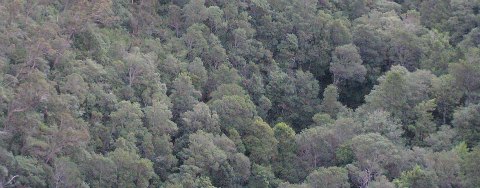Home | About CCW | Contact Us | Climate change Meaning | Causes | Solutions | Emissions | Carbon trading
Carbon offsets
Carbon offsets are created from activities that either reduce greenhouse gas emissions (mitigation), prevent emissions that would occur under business as usual (abatement) or capture carbon from the atmosphere and store it (sequestration).
There are two types of sequestration:
- carbon capture and storage (or CCS)
- biosequestration
Carbon capture and storage is the engineering solution where CO2 is captured where it is emitted at the power plant and stored below ground. This is an expensive, technically challenging process with uncertain local environmental effects.
Biosequestration is the capture of CO2 by plants and then storage of carbon in vegetation and soil. It has significant potential in regrowing forest (reforestation), growing trees on non-forest land (afforestation) and in soils, especially in the rehabilitation of degraded soils.
Activities that deliver mitigation, abatement or sequestration can create carbon credits with each credit equivalent to an emissions reduction of one tonne of carbon dioxide equivalents [tCO2e].
These credits can then be used as an offset against greenhouse gas emissions by emitters with an obligation to account the carbon they release to the atmosphere.
It is an example of the polluter pays principle.
If I have no choice but to emit a greenhouse gas from my business activity that might be a coal-fired power plant, then I can pay to buy a permit to do so, or buy a carbon credit to offset part or all of my emissions so that the net effect of my activity on the atmosphere is neutral.
If I can source offset credits on a market Iit might be cheaper for me than buying a permit. The creation of offsets also has net benefit for emission reduction than if permits were not created.
Carbon offsets must be measurable
It is important that any carbon credit is real.
One credit is expected to represent one metric ton of greenhouse gas (as CO2 equivalents) not emitted to, or no longer in, the atmosphere.
Detailed accounting systems have been developed to record the actual amounts of CO2 equivalents beginning with those for the Clean Development Mechanism of the Kyoto protocol and now with many more under the various carbon standards in compliance and voluntary markets.
Among other things, these carbon accounting systems ensure that each credit generated from an offset project is real, accurate, and permanent.
In order to claim credits for an offset activity it is necessary to apply the accounting rules, complete carbon accounts and have the numbers checked by independent auditors.
This ensures a net benefit of offset creation toward the goal of emission reduction even if the growth on economic activity means that the absolute amount of greenhouse gas emitted continues to rise.
What is the current global offset volume?
The 2010 World Bank 'State and Trends of the Carbon Market' report estimates carbon offset volume from project based activity at 283 million tCO2e in 2009.
Offset credits from project activity is roughly 1% of the estimated global greenhouse gas emissions volume of 29 billion tCO2e for 2007.
Overall around 7.3 billion tCO2e were traded on the carbon market.
This larger figure is due the trading of credits being far greater than the generation of credits. Trades are equivalent to 25% of emissions.
But trades are not emission reductions as far at the atmosphere is concerned.
What is the global offset potential?
This number is harder to estimate.
The creation of mitigation, abatement, and sequestration projects has slowed as a result of uncertainty in the market that has led to a shortage of investment funds.
There is considerable untapped potential in biosequestration projects especially in tropical forests and agriculture that are called Land Use and Land Use Change (LULUC) under the UNFCC and in Agriculture, Forests and Other Land Use (AFOLU) projects under the voluntary system.
Ratten Lal, a global soils expert, estimates that there is the potential to sequester up to 7.3 billion tCO2e of carbon in the worlds degraded soils if we change land use practices to rehabilitate them.
Avoiding the deforestation of 100,000 ha of tropical forest would avoid up to 600,000 tCO2e each year.
If offset credits had enough of a market, there is potential for the wide range of project types to go a long way towards meeting emission reduction targets.
Potential is greater than supply
Supply is constrained by the crediting system. Creation of projects that have complied with all the checks and balances takes time. And time is money that can be in short supply in an uncertain market .
Some of the carbon offsets projects can individually and collectively generate large credit volume. This can have a destabilizing effect on price if released in bulk to the market.
This goes against the idea of a market that requires a high credit price that to drive activity toward alternatives.
Demand from emitters may not absorb the dumping of credit volume but multinational corporations and country obligations to targets is another matter. With the capacity to purchase in bulk, governments, such as Australia, with offset requirements will look to do mega-deals.
When such purchases are for carbon in tropical forests they can even be labeled as philanthropic.
This is the controversial topic of REDD, reduced emissions from deforestation and degradation. REDD has a passionate community of advocates who see an opportunity to slow timber harvest and protect rainforests as well as equally vocal detractors.In the end the controversies over supply, demand and the purchasing behaviour of different types of buyer make the carbon markets complex and tricky to interpret.
What we do know is that carbon offsets activities are essential to create carbon credits.
Without credits there can be no carbon trading and, perhaps more significantly, without mitigation, abatement, and sequestration projects the net effect of human activity will be to increase greenhouse gas concentrations.
Carbon offsets challenges
Carbon offsets are a useful addition to a market mechanism for emission reduction so long as the process follows the script.
Australia, the first to set up a domestic offset market, has found there are significant challenges in doing this.
The ‘elephant in the bathroom may have farted’ post on climate-change-wisdom sister blog, alloporus, tells us that the possibility we all knew was there — that market forces can go in both directions — now seems likely for the Australian carbon market.
At the end of the fixed price period in 2015, the carbon price in Australia may be considerably less than $24. The new estimate is $10 per tCO2e, a shortfall that would deliver a $4 billion budget ouch on forward projections for the government.
In 2012 the Australian government decided to remove the collar on the carbon price originally proposed for the 2015-18 period, presumably to allow alignment with the EU carbon market. It also allowed Australian companies to buy up to 50% of their permit requirement from international credits. This means that the domestic carbon price is more likely to track international markets, hence the potential permit price of $10 at the end of the fixed price period in 2015.
Not quite what is supposed to happen if the policy is to work, not least for the nascent carbon offsets market.
update on Australia — in September 2013 an election in Australia produced a change of government and after a short time a repeal of the previous carbon price legislation. This means that there is no longer a carbon price or a mechanism to trade any carbon offsets as carbon credits. However, the new government has proposed 'Direct Action' that will buy emission reduction from projects that result in carbon abatement or sequestration in order to meet agreed emission reduction targets.
Recalling what carbon credits are all about — short version is that credits can be generated from activities that abate, reduce emissions or sequester carbon into the landscape [e.g. capturing and burning landfill gas, growing trees on degraded land, managing manure from piggeries] so long as the activity complies with a several important carbon accounting rules — then we have the potential for mitigation and sequestration from many different activities.
But these activities cost money. This means there will be consequences of $10 tCO2e for carbon offsets.
Challenge #1
When the permit price is low, then carbon credit prices will be lower still, around 10-15% usually.
This makes sense because why go to the trouble of buying an offset credit if it is the same price as a permit? The only time you might is when you have some desire to commit a random act of kindness or to get PR advantage from the co-benefits that offset credits can bring. So usually credits are cheaper than permits.
A $9 carbon credit will severely limit the number of offset activities that can be financially viable whilst still complying with all the rules.
In energy, infrastructure, waste and land based carbon projects it will be very hard to cover activity, transaction and opportunity costs of project implementation from a $9 tCO2e return.
Challenge #2
When projected revenue is halved the last thing a government would want is for emitters to buy offset credits instead of permits. Large-scale emitters will act rationally and buy offsets if they are cheaper only this money goes to the offset provider and not treasury. This makes the fiscal hole deeper.
There is also the significant risk that too many offsets could further deflate the price by increasing supply. This was probably the main, but rarely stated, reason for why REDD [reduced emissions from degradation and deforestation] mechanisms that generate credits from protection of tropical forests have not been embraced — too much credit volume further depresses the carbon price.
So we can expect government to be much less enthusiastic about offset credits, at least the complaint kind that can be exchanged for permits. They will, of course, continue to promote and talk up voluntary offset credits, the ones you might buy to offset a flight or a company might purchase in order to be carbon neutral.
It should be no surprise that, despite the fanfare, Australia’s domestic offset scheme called the CFI is taking a very long time to get going.
update on Australia — note that both these challenges still apply to the latest policy of 'Direct Action' to purchase emission reduction proposed by the Australian government to replace the CFI
What carbon offsets were supposed to do?
Remember that the climate change policy that puts a price on carbon was all about reducing greenhouse gas emissions from human activities by making it increasingly more expensive for emitters to carry on emitting under business as usual.
Create sufficient pain in the hip pocket and there will be a change in behavior.
Emitters will become more efficient, saving energy themselves, or pass the price on to consumers who will become more frugal. If it the price continues to rise and efficiency gains are exhausted then it pays to make more substantial shifts in behavior, mostly toward alternative energy sources.
At $9 tCO2e for an offset there is not enough pain to make the change.
update on Australia — under direct action carbon offset projects will compete to provide offset volume at the cheapest price to the buyer [government]. But now offset is not linked to emissions so the rather odd situation can arise where an emitter who can also produce offsets, for example, a coal mine that captures and flares fugitive methane from coal extraction.
Some might argue this is paying being paid to emit
climate change wisdom › solutions › carbon offsets
Recent Articles
-
Reducing emissions while looking for solutions...
Nov 01, 15 04:46 PM
I've seen a lot of post's online for ideas on reducing emissions. The one suggestion I have not seen, is the most obvious. There should be a government -
Climate change evidence
Mar 24, 15 06:22 AM
Real climate change evidence has to demonstrate a change in climate. An extra sunny day or a severe storm or a flood is not enough. -
The climate change effect
Feb 19, 15 03:08 AM
What will be the climate change effect? There isn't one, there are many. Perhaps too many for us to understand.




New! Comments
Have your say about what you just read! Leave me a comment in the box below.